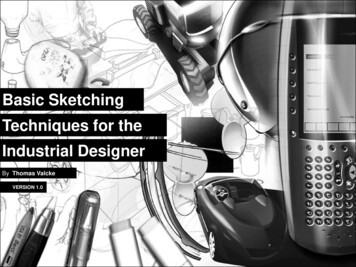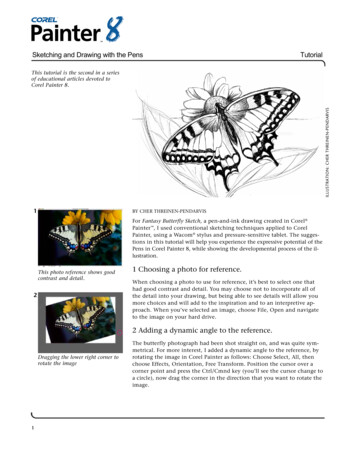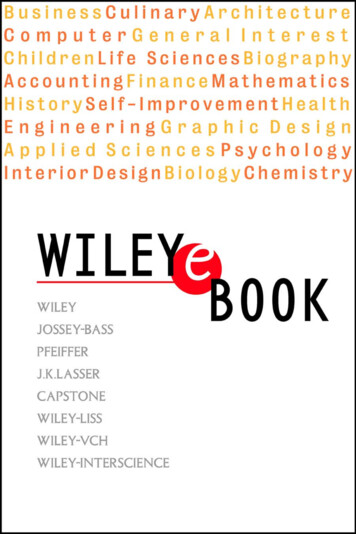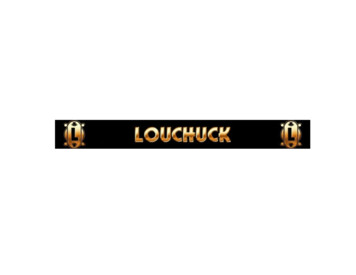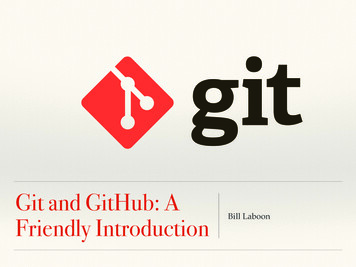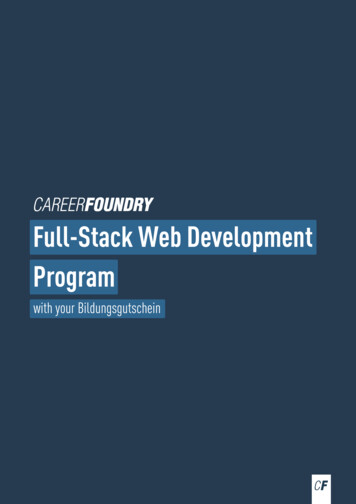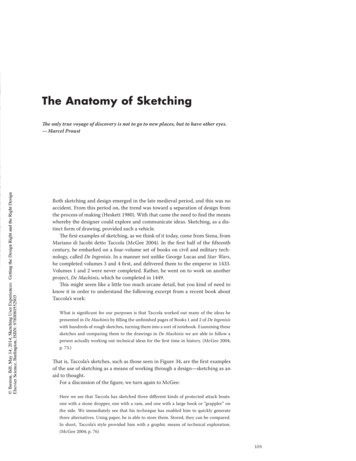
Transcription
The Anatomy of Sketching Buxton, Bill, May 14, 2014, Sketching User Experiences: Getting the Design Right and the Right DesignElsevier Science, Burlington, ISBN: 9780080552903The only true voyage of discovery is not to go to new places, but to have other eyes.— Marcel ProustBoth sketching and design emerged in the late medieval period, and this was noaccident. From this period on, the trend was toward a separation of design fromthe process of making (Heskett 1980). With that came the need to find the meanswhereby the designer could explore and communicate ideas. Sketching, as a distinct form of drawing, provided such a vehicle.The first examples of sketching, as we think of it today, come from Siena, fromMariano di Jacobi detto Taccola (McGee 2004). In the first half of the fifteenthcentury, he embarked on a four-volume set of books on civil and military technology, called De Ingenisis. In a manner not unlike George Lucas and Star Wars,he completed volumes 3 and 4 first, and delivered them to the emperor in 1433.Volumes 1 and 2 were never completed. Rather, he went on to work on anotherproject, De Machinis, which he completed in 1449.This might seem like a little too much arcane detail, but you kind of need toknow it in order to understand the following excerpt from a recent book aboutTaccola’s work:What is significant for our purposes is that Taccola worked out many of the ideas hepresented in De Machinis by filling the unfinished pages of Books 1 and 2 of De Ingenisiswith hundreds of rough sketches, turning them into a sort of notebook. Examining thesesketches and comparing them to the drawings in De Machinis we are able to follow aperson actually working out technical ideas for the first time in history. (McGee 2004;p. 73.)That is, Taccola’s sketches, such as those seen in Figure 34, are the first examplesof the use of sketching as a means of working through a design—sketching as anaid to thought.For a discussion of the figure, we turn again to McGee:Here we see that Taccola has sketched three different kinds of protected attack boats:one with a stone dropper, one with a ram, and one with a large hook or “grappler” onthe side. We immediately see that his technique has enabled him to quickly generatethree alternatives. Using paper, he is able to store them. Stored, they can be compared.In short, Taccola’s style provided him with a graphic means of technical exploration.(McGee 2004; p. 76)105
PART I: Design As DreamcatcherNow let us move from the renaissance to the present. For the sake of argument, letus assume that design and sketching are related. Furthermore, let us assume thatwe can gain insights about design by way of cultivating a better understanding ofsketching. Doing so is not too much of a stretch. For example, museums such asBoijmans Van Beuningen in Rotterdam exhibit sketches, models, and prototypesin their own right, as a means to inform us about the process of product design. Buxton, Bill, May 14, 2014, Sketching User Experiences: Getting the Design Right and the Right DesignElsevier Science, Burlington, ISBN: 9780080552903In the past few years within the profession of industrial design there has been increasingattention on the story behind the object, in which sketches, design drawings, models andprototypes play a prominent role. They make possible a reconstruction of the interestinghistory of their origin. Above all they make visible the designer’s contribution, which isoften very different to what one might expect. (te Duits 2003; p.4)In this spirit, I want to introduce a number of sketches that were generated in thecourse of realizing a product, in this case a time-trial racing bicycle designed forLance Armstrong for the Tour de France. These appear as Figures 35 through 39.The first four images are in chronological order. The first three take us from sketchto engineering drawing. The visual vocabulary of all the figures is different, andit is important to keep in mind that these variations are not random. Rather, theyare the consequence of matching the appropriate visual language to the intendedpurpose of the rendering. The conscious effort of the designer in doing so is perhaps most reflected in Figure 38, where the designer has gone to extra effort to“dumb down” the rendering in order to ensure that it did not convey a degree ofcompletion that was not intended.In looking at the drawings, keep in mind that they follow only one of the manyconcepts explored—the one that was eventually built. Early in the design processit would not be unusual for a designer to generate 30 or more sketches a day. Eachmight explore a different concept. The figures used are intended to show different styles of visual representation of just one of these, not to show the breadth ofideas considered.Looking at them individually, we see that Figure 35 is clearly a sketch. Its visualvocabulary suggests that it was hand drawn, quickly and effortlessly, by a skilledartist. It says that it does not represent a refined proposal, but rather simply suggests a tentative concept. But what is it in the vocabulary that tells us all this?Largely, it is the freedom, energy, abandon, and looseness of the lines. It is thefact that the lines continue on past their natural endpoints. It tells us no rulerswere used.Even if the designer laboured for hours (or even days) over this rendering, andused all kinds of rulers and other drafting tools, it does not matter. The renderingstyle is intended to convey the opposite, because the designer made this sketchwith the clear intention of inviting suggestions, criticisms, and changes. By conveying the message that it was knocked off in a matter of minutes, if not seconds,the sketch says, “I am disposable, so don’t worry about telling me what you reallythink, especially since I am not sure about this myself.”106
Buxton, Bill, May 14, 2014, Sketching User Experiences: Getting the Design Right and the Right DesignElsevier Science, Burlington, ISBN: 9780080552903The Anatomy of SketchingFigure 36 is a refinement of the previous sketch. It has all the sketch-like properties of Figure 35, but includes rough shading in order to tell the viewer moreabout the detailed 3D form of the concept being pursued. As in the previoussketch, it would look at home on the wall of a drawing class. It says, “I’m thinkingseriously about this form, but the ideas are still tentative. But as I am getting moreserious, tell me now what you think.”Figure 37 is not a sketch. This is a “serious” piece of work. Because of the wireframe mesh on the surface, the precision of the lines, and the quality of the corporate graphics, this rendering says that it took a lot of care and work, and that itwas done on a computer. It is a 2D rendering of an accurate 3D model of the entireframe. Compared to the previous two drawings, it says “expensive” and “refined”(although the retention of the wireframe mesh in the rendering also says “but notfinished”). It says, “We have made some decisions and are seriously consideringthis path.”Let me put it this way: of the dozens of concepts worked up to the level of thefirst two sketches, very few would be taken to this stage. To any literate reader ofdrawings, this is implicit in the style of rendering itself. The funnel is converging.Now we move to my favourite rendering, Figure 38.This is a hybrid. What the designer has done is make a photorealistic threequarter view rendering of the 3D model previously seen in Figure 37. He has thenmade a composite with it and the hand-drawn sketch seen in Figure 35. But whywould he do this? He was working to a tight deadline. He had no time to spare,and this took extra work. He already had done the 3D model. He just could haveused the photorealistic three-quarter view rendering on its own. The answer isin the figure itself. The extra effort was undertaken to imbue the resulting imagewith the quality of a sketch. To make it look all the more effortless. To say, “Thisisn’t finished,” and to invite suggestions and communicate that the design was stillopen to change.Now look at Figure 39. By this stage it is clear that these are examples of sketches. These types of sketches are actually among the first ones done in a project.Michael Sagan, the designer, describes his process and use of such thumbnailsketches as follows:Typically I do very loose thumbnails to capture a gesture or a theme to start out. OftenI will jot down words or phrases that I use as a semantic guide. As a design review step Iwill have another designer evaluate my 3D work checking back against my thumbnailsand semantic guide-words. If the designer hits any of the words I count that as a success.In the case of this sheet that I included here one designer picked out almost all of thewords much to his surprise when I showed him these images.Finally, note the following. First these thumbnail sketches were made in the courseof designing what, at the time, was probably the most technologically advancedbicycle ever built. Second, stylistically speaking, they are completely in keepingwith, and would be perfectly at home in, the sketchbooks of Taccola.107
Figure 35: Early ThreeQuarter View Sketch of TimeTrial BikeAlthough done on a computer,this is a freehand sketch. Notice that the representation istentative. What tells you this?Contrast this to the representation in Figure 37.Credit: Michael Sagan, Trek Buxton, Bill, May 14, 2014, Sketching User Experiences: Getting the Design Right and the Right DesignElsevier Science, Burlington, ISBN: 9780080552903BicyclesFigure 36: Shaded ThreeQuarter View Sketch of TimeTrial BikeThis is a refinement of thesketch seen in Figure 35.Through the use of shading,the sketch communicatesmore about the 3D form ofthe concept. Notice that despite this refinement linesstill extend through the “hardpoints.”Credit: Michael Sagan, TrekBicycles108
Figure 37: Side View of 3DShaded Model of Time TrialBikeThis is a side view of the samebike seen in the previous twofigures. Contrast this representation to that in Figure 36.Both are shaded to highlightthe form. Ignoring the addition of the graphics for themoment, is it obvious, is itclear which of the two is morerefined, closer to “final,” and Buxton, Bill, May 14, 2014, Sketching User Experiences: Getting the Design Right and the Right DesignElsevier Science, Burlington, ISBN: 9780080552903which took the most effort tocreate, and which will takethe most effort to redo in theevent of a change or suggestion. This image is clearly nota sketch.Credit: Michael Sagan, TrekBicyclesFigure 38: Accurate 3DShaded Model Superimposed Over Three-QuarterView SketchThis image is perhaps themost interesting. It is a composite of a three-quarter viewof the 3D model seen in Figure 37 superimposed overthe sketch seen in Figure35. Given what we have seenthus far, ask yourself why thedesigner would do this.Credit: Michael Sagan, TrekBicycles
Buxton, Bill, May 14, 2014, Sketching User Experiences: Getting the Design Right and the Right DesignElsevier Science, Burlington, ISBN: 9780080552903PART I: Design As DreamcatcherFigure 39: Thumbnail Sketches, Scanned from SketchbookIn what century were these made? Yesterday? During the renaissance?You can’t tell from the form, only from the content.Credit: Michael Sagan, Trek Bicycles110
The Anatomy of SketchingSketching is not only the archetypal activity of design, it has been thus forcenturies. Buxton, Bill, May 14, 2014, Sketching User Experiences: Getting the Design Right and the Right DesignElsevier Science, Burlington, ISBN: 9780080552903Having come this far, what I would like to do now is step back and try to use whatwe have seen in these examples as a means to come to some characterization ofsketches in general.What I am after here is an abstraction of sketches and sketching. What I want is to go meta and identify a set of characteristics whose presenceor absence would let us determine if something is, or is not, a sketch —at least inthe way that I would like to use the term.Here is my best attempt at capturing the relevant attributes of what we haveseen and discussed. Sketches are:Quick: A sketch is quick to make, or at least gives that impression.Timely: A sketch can be provided when needed.Inexpensive: A sketch is cheap. Cost must not inhibit the ability to explore aconcept, especially early in the design process.Disposable: If you can’t afford to throw it away when done, it is probably nota sketch. The investment with a sketch is in the concept, not the execution. Bythe way, this doesn’t mean that they have no value, or that you always disposeof them. Rather, their value largely depends on their disposability.Plentiful: Sketches tend not to exist in isolation. Their meaning or relevance is generally in the context of a collection or series, not as an isolatedrendering.Clear vocabulary: The style in which a sketch is rendered follows certainconventions that distinguish it from other types of renderings. The style, orform, signals that it is a sketch. The way that lines extend through endpointsis an example of such a convention, or style.Distinct gesture: There is a fluidity to sketches that gives them a sense ofopenness and freedom. They are not tight and precise, in the sense that anengineering drawing would be, for example.Minimal detail: Include only what is required to render the intended purpose or concept. Lawson (1997, p. 242) puts it this way, “ it is usually helpfulif the drawing does not show or suggest answers to questions which are notbeing asked at the time.” Superfluous detail is almost always distracting, atbest, no matter how attractive or well rendered. Going beyond “good enough”is a negative, not a positive.111
Buxton, Bill, May 14, 2014, Sketching User Experiences: Getting the Design Right and the Right DesignElsevier Science, Burlington, ISBN: 9780080552903
The Anatomy of Sketching Buxton, Bill, May 14, 2014, Sketching User Experiences: Getting the Design Right and the Right DesignElsevier Science, Burlington, ISBN: 9780080552903Appropriate degree of refinement: By its resolution or style, a sketch shouldnot suggest a level of refinement beyond that of the project being depicted.As Lawson expresses it, “ it seems helpful if the drawing suggests only alevel of precision which corresponds to the level of certainty in the designer’smind at the time.”Suggest and explore rather than confirm: More on this later, but sketchesdon’t “tell,” they “suggest.” Their value lies not in the artifact of the sketch itself,but in its ability to provide a catalyst to the desired and appropriate behaviours, conversations, and interactions.Ambiguity: Sketches are intentionally ambiguous, and much of their valuederives from their being able to be interpreted in different ways, and new relationships seen within them, even by the person who drew them.In the preceding, the notions of visual vocabulary, resolution, and refinement arereally significant, and interdependent. Sketches need to be seen as distinct fromother types of renderings, such as presentation drawings. Their form should define their purpose. Any ambiguity should be in the interpretation of their content,not in terms of the question, “Is this an early concept or the final design?” a sketch is incomplete, somewhat vague, a low-fidelity representation. The degree offidelity needs to match its purpose, a sketch should have “just enough” fidelity for thecurrent stage in argument building. Too little fidelity and the argument is unclear. Toomuch fidelity and the argument appears to be over—done; decided; completely workedout . (Hugh Dubberly of Dubberly Design Office; private communication)Some of the most serious problems occur if various parties—managers and/or customers and/or marketing—begin to view the early prototypes [read sketches] they see as thefinal product. (Hix and Hartson 1993; p. 260)Finally, in its own way, our list is more than not like a sketch itself. It is tentative,rough, and has room for improvement and refinement. And also like a sketch,these same values may very well contribute to, rather than reduce, its usefulness.Figure 40: Designing a PerformanceThe outcome of any design process is a desired effect. Sketches have to be understood as steps in this process. While the beauty or clarity of each individualdrawing might be appealing to the designer, ultimately the goal is to attain theperformance declare at the beginning of the design process. This awareness iswhat differentiate a dexterous designer from a proficient renderer.Credit: Trek Bicycles113
Create Buxton, Bill, May 14, 2014, Sketching User Experiences: Getting the Design Right and the Right DesignElsevier Science, Burlington, ISBN: 9780080552903(seeing that)mindsketch(new) knowledgerepresentationRead(seeing as)Figure 41: A Sketch of a Dialogue with a SketchThe “conversation” between the sketch (right bubble) and the mind (leftbubble). A sketch is created from current knowledge (top arrow). Reading,or interpreting the resulting representation (bottom arrow), creates newknowledge. The creation results from what Goldschmidt calls “seeingthat” reasoning, and the extraction of new knowledge results from whatshe calls “seeing as.”
Sketching Interaction Buxton, Bill, May 14, 2014, Sketching User Experiences: Getting the Design Right and the Right DesignElsevier Science, Burlington, ISBN: 9780080552903When you come to a fork in the road, take it!— Yogi BerraSo how might we find a process that enables us to design computer-based products with the same attention to userexperience that we saw in the design of the OrangeX? I think that the answer lies in the OrangeX example, itself.Hence its importance.It illustrated that the activity of sketching could be extended to other forms than just pencil on paper. The keyhere is to understand that sketching as I mean it has more to do with exercising the imagination and understanding (mental and experiential) than about the materials used. Hence, one might use pencil on paper, but one mightalso use a jar lid, a stick, and a piece of plasticine. It may even involve a computer. With the OrangeX example, theunderlying process and objectives were the same, but the sketches themselves took on a more physical form thanwe have seen thus far. As I shall say more than once, the importance of sketching is in the activity, not the resultingartifact (the sketch). If sketches can take on physical form, be they 3D or sculptural, perhaps they can take on evenmore extended forms that will help us in our quest.But how do we go deeper than this? If there are new forms of sketching, how can we pursue them?One thing that we know is that sketches for experience and interaction design will likely differ from conventionalsketching since they have to deal with time, phrasing, and feel—all attributes of the overall user experience. Howrich is that?Experience is a very dynamic, complex and subjective phenomenon. It depends upon the perception of multiple sensory qualities of a design, interpreted through filters relating to contextual factors. For example, what is the experience of a run down amountain on a snowboard? It depends upon the weight and material qualities of the board, the bindings and your boots, thesnow conditions, the weather, the terrain, the temperature of air in your hair, your skill level, your current state of mind, themood and expression of your companions. The experience of even simple artifacts does not exist in a vacuum but, rather, indynamic relationship with other people, places and objects. Additionally, the quality of people’s experience changes over timeas it is influenced by variations in these contextural factors. (Buchenau & Suri 2000; p 424)In light of this, let us ask again:What is the nature of sketching in interaction design?How do you sketch interaction?What is to an interactive system what the early sketch in Figure 35 is to Lance Armstrong’s time trial bike?What are the fundamental skills required for sketching interactive systems?What is the underlying process that one should follow to do this effectively and consistently?What should be included in Sketching 101 in an Interaction Design curriculum?135
Buxton, Bill, May 14, 2014, Sketching User Experiences: Getting the Design Right and the Right DesignElsevier Science, Burlington, ISBN: 9780080552903PART I: Design As DreamcatcherThe tack that we are going to pursue is that sketching in interaction design can be thought of as analogous to traditional sketching. Since they need to be able to capture the essence of design concepts around transitions, dynamics,feel, phrasing, and all the other unique attributes of interactive systems, sketches of interaction must necessarilybe distinct from the types of sketches that we have looked at thus far. Nevertheless, to be considered sketches, theymust be consistent with the attributes that we discussed earlier, ear vocabularyDistinct gestureMinimal detailAppropriate degree of refinementSuggest and explore rather than confirmAmbiguityFrom our analysis of sketching in traditional design, we are able to find a compass that can help guide us in ourexploration of sketching in this new domain. Although the surface of the renderings will be different, the underlying properties should be the same. Therefore, not only do we have a compass, we have a litmus test that helps uscategorize examples that we encounter.136
Buxton, Bill, May 14, 2014, Sketching User Experiences: Getting the Design Right and the Right DesignElsevier Science, Burlington, ISBN: 9780080552903Experience Design vs. Interface Design137
Buxton, Bill, May 14, 2014, Sketching User Experiences: Getting the Design Right and the Right DesignElsevier Science, Burlington, ISBN: 9780080552903Figure 51: The Dynamics of the Design FunnelThe design funnel begins with ideation, and ends with usability testing. Theformer is largely dominated by sketching, which enables ideas to be exploredquickly and cheaply. More refined (and expensive) prototypes provide the basis for the testing at the later stages of design. Where testing is a key concern,the most dominant artifacts are more refined (and expensive) prototypes.The transition from one to the other is represented by the transition fromorange to yellow in the figure. As we progress, our overall investment in theprocess grows. This is indicated by the rising arrow and the y-axis label onthe left. The y-axis label on the right side of the figure emphasizes that asour investment increases, so should the weight of the criteria that we useto evaluate our design decisions. In other words, you don’t manage ideationthe same way, or with the same rigor, as usability. Finally, the circular arrowsare a reminder that we include users throughout the iterative process, notjust during usability testing.
Sketches are not Prototypes Buxton, Bill, May 14, 2014, Sketching User Experiences: Getting the Design Right and the Right DesignElsevier Science, Burlington, ISBN: 9780080552903Practice is the best of all instructors— Publius SyrusNow that what I mean by sketching interaction is becoming a bit more clear, it is inevitable thatsomeone is going to ask something like, “Isn’t what you are calling a sketch just another word forprototype or low-fidelity prototype?” The answer is emphatically, “No!” The distinction between asketch and a prototype is—for me at least—one of the most interesting things to emerge as I wentdown this path.Sketches and prototypes are both instantiations of the design concept. However they serve different purposes, and therefore are concentrated at different stages of the design process. Sketches dominate the early ideation stages, whereas prototypes are more concentrated at the later stages wherethings are converging within the design funnel. Much of this has to do with the related attributes ofcost, timeliness, quantity, and disposability. Essentially, the investment in a prototype is larger thanthat in a sketch, hence there are fewer of them, they are less disposable, and they take longer to build.At the front end of the funnel, when there are lots of different concepts to explore and things are stillquite uncertain, sketching dominates the process.These notions are captured graphically in Figure 51. The circular arrows reinforce that the wholedesign phase is an iterative, user-centred process. The coloured change reflects a transition from aconcentration on sketching at the front to one concentrating on prototyping at the back. Related tothis, and signified in the colour coding, is the accompanying transition from ideation to usabilitytesting.From the management perspective, perhaps the most important component of Figure 51 is theascending red arrow. What this says is that the weight of the criteria by which ideas or concepts areinjected or rejected varies with the investment made in them. Stated simply, at the beginning, ideasare cheap, so “easy come, easy go” and “the more the merrier.” As we proceed, we have more and moreinvested in the concepts in play, hence we need to adopt increasingly formal or explicit criteria forevaluating what goes, what stays, and where we invest our resources.Because the investment in the product is low, the front end is the one time in the product pipelinewhen one can actually afford to play, explore, learn, and really try and gain a deep understanding ofthe undertaking. In fact, too much concern for quality too early may well have a negative effect. Ifound a wonderful example illustrating what I mean by this referred to in a blog from someone calledBill Brandon:139
Buxton, Bill, May 14, 2014, Sketching User Experiences: Getting the Design Right and the Right DesignElsevier Science, Burlington, ISBN: 9780080552903Figure 52: The Sketch to Prototype ContinuumThe difference between the two is as much a contrast of purpose, or intent,as it is a contrast in form. The arrows emphasize that this is a continuum,not an either/or proposition.
Sketches are not Prototype Buxton, Bill, May 14, 2014, Sketching User Experiences: Getting the Design Right and the Right DesignElsevier Science, Burlington, ISBN: 9780080552903The ceramics teacher announced on opening day that he was dividing the class into two groups. All those on theleft side of the studio, he said, would be graded solely on the quantity of work they produced, all those on the rightsolely on its quality. His procedure was simple: on the final day of class he would bring in his bathroom scalesand weigh the work of the “quantity” group: fifty pounds of pots rated an “A”, forty pounds a “B”, and so on. Thosebeing graded on “quality,” however, needed to produce only one pot—albeit a perfect one—to get an “A.” Well,came grading time and a curious fact emerged: the works of highest quality were all produced by the group beinggraded for quantity. It seems that while the “quantity” group was busily churning out piles of work—and learningfrom their mistakes—the “quality” group had sat theorizing about perfection, and in the end had little more toshow for their efforts than grandiose theories and a pile of dead clay. (Bayles & Orland 2001; p. 29)Baxter (1995) argues that because the investment is so low and the opportunity to explore options is sohigh at the start, that this is also the stage in the product development lifecycle when you have the potential to realize the highest return on investment. Of course, this is a double-edged sword. It is also thepoint in the process where the consequences of an undetected bad decision, or an opportunity missed,can cost you the most (in real dollars or missed revenue). So, as the saying goes:Fail early and fail often.And learn.But adequate investment at this stage happens too infrequently, especially with software companies.The paradox is that those same firms that can’t afford a relatively small planned investment in designat the front end, seem quite able to afford the far higher unexpected and unbudgeted (but predictable)high back-end costs that result from a bad product being late and underdelivering on its potential.Jumping in and immediately starting to build the product, even if it does get completed and ship,is almost guaranteed to produce a mediocre product in which there is little innovation or market differentiation. When you have only one kick at the can, the behaviour of the entire team and process is aspredictable as it will be pedestrian:You cling ever more tightly to what you already know you can do—away from risk and exploration, and possiblyfurther from the work of your heart. (Bayles & Orland 2001; p.30)Robert Cooper (1993; 2001) compares managing product development costs in terms of the type of riskanalysis that one would use at the poker table, or in managing an investment portfolio. Mike Baxtersummarizes this in terms of the following Gambling Rule:When uncertainties are high, keep the stakes low. As the uncertainties reduce, increase the stakes. (Baxter 1995;p.10)In summary, what all this says is that we must manage the front-end of the process differently than theback-end, regardless of whether we are looking at things in the large (the overall product pipeline—design, engineering, sales, etc.) or in the small (within the design funnel itself, where we must manage thesketching and ideation phase differently than we manage the back-end prototyping stage).141
Figure 36 is a refinement of the previous sketch. It has all the sketch-like prop-erties of Figure 35, but includes rough shading in order to tell the viewer more about the detailed 3D form of the concept being pursued. As in the previous sketch, it would look at home on the wall of a drawing class. It says, "I'm thinking





